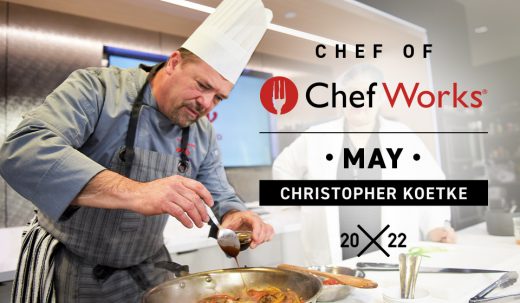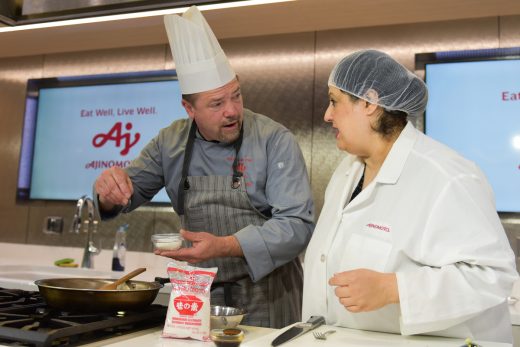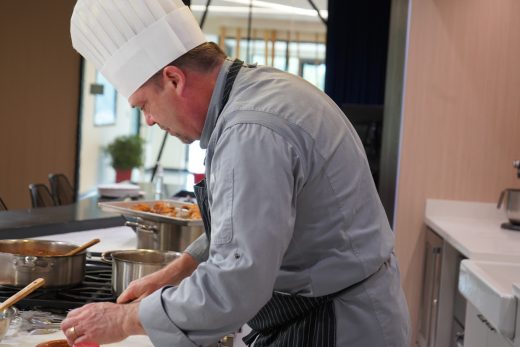
Every human being is undeniably unique. The question is: How do you create a career that’s as one-of-a-kind as you? Take some advice from Chef Christopher Koetke: “Make your five-year plan, but hold it loosely.” In this month’s Chef of Chef Works feature, Chef Chris shares with us his own journey in the culinary industry and how the never-ending work of learning has led to his “favorite job ever” as Corporate Executive Chef at Ajinomoto Health & Nutrition North America.
Read on to learn about his hunger for knowledge (and all things umami), what lies ahead for the culinary industry after a challenging yet powerful couple of years, and, more importantly, how you can also create a career that keeps you captivated decades later.
Chef Works: Can you share a little of your career story up until now?
Chef Christopher Koetke:
I started in this business when I was super young. I’m one of those weird people — when I was 12 years old, I was like “This is what I want to do.” It happened in a moment in time when I could still remember where I was and from that moment on, I never looked back. I started taking cooking classes when I was 12, and I started working when I was 14… actually younger at 13, but that was illegal, so nobody really talks about it (laughs). I’ve been in this business for over four decades, but I didn’t go to culinary school. Back in the day, culinary school wasn’t like today where you apply and there were not a lot of schools. I looked into it, but eventually, I wound up going to a university, partially because my father was a professor. He told me, “You should really do it because it’s free.” At the time, I didn’t understand how good that was. My career started in American-style restaurants when I was still young. As soon as I could, I moved to Chicago and started working there.
My goal was to go into fine dining. I saw fine dining as the pinnacle of the art form. It was the thing you’d spend hours on, trying to get to that level where you could really say it’s perfect — which, of course, is elusive, right? But it’s the struggle to get there — that’s what captivated me. I sort of grew up through the school of hard knocks. I worked in France. I worked in Switzerland. I worked for the 2- and 3-star Michelin guys. I bounced around, wound up in the US, and spent five years working for one of the top restaurants called Le Français. The restaurant no longer exists, though it sort of slid into culinary history. Eventually, I was chef of a place in downtown Chicago, which, at the time, was one of the top 10 in the city. I was doing fun stuff, literally changing the menu every day. I was driving all over the place, going to markets, and learning where the best bacon was or where the best sausages were. It was the European model where you get up very early and drive around to get your ingredients. I loved it.

Then, my career took a funny turn. I was having a blast in the restaurant, working like crazy, getting great reviews — when I got a phone call one day from a culinary school, and they asked “Do you want to teach?” This was never my plan, right? But they said, “You know, you have seven weeks off a year and weekends. I was like, “Wait, excuse me, was that seven? (laughs)” I had two young kids at the time, so I said, “I’ll do that for two years.” And then, that lasted 20.
I was looking after 48 campuses in 12 countries, spending a good third of my year outside the US blowing through passports every three and half years. It was an amazing time of growth. I grew up in that French model, you know. Back in the day, it was all about French food. It was the era of Julia Child, who as a parenthesis, was actually my pen pal and mentor when I was 15 and 16, but that’s a whole separate story. When I traveled, I started spending time with the top chefs in India, Thailand, Japan, Mexico, Chile, Ecuador, and all of these countries — it made me realize that the world of food is so much bigger than any of us could possibly imagine, and it’s so infinitely fascinating. I would go to these countries and I would be like, I think I know something about *pick your country* — and then when you get to it, you realize you know absolutely nothing. And then the learning starts. You become what we always talk about in the educational world: a lifelong learner. But anyways, that was for 20 years. It was a great experience. And then I moved to sort of do my own thing a little bit. And now I am Corporate Executive Chef here at Ajinomoto Health & Nutrition, North America. And it is, I have to say, probably my favorite job ever.
Chef Works: What makes it your favorite?
Chef Chris:
At its origin, the founder of Ajinomoto was the guy who discovered umami, figured out what it was, named it as such. So they have been in the world of not only producing MSG but many ingredients which are designed to maximize flavor and texture in food. What does that mean? I get to be surrounded by really, really smart people. Food scientists who I work with very closely, and as I said earlier, I’m a lifelong learner. I’m now in a position where, as a chef, I bring a lot of value in terms of making food taste and look amazing — everything that I know how to do as a chef. But then I talked to the scientists and they start to tell me why it happens. I feel like I’m drinking from a fire hose in terms of what I’m learning here. It’s just… it’s exhilarating. It really is. And not only am I surrounded by really smart people, but it’s just a great environment here. Everyone’s just very open and sharing and we’re super collaborative.
In addition to that, Ajinomoto really takes into account many of the things I’ve done in my career, so it kind of all fits together. I do a lot of educating, I spend time with chefs, and I spend time with people in the larger food industry (like nutritionists) and really educate them on what is this thing called umami, or what is this thing called kokumi, or how do we use amino acids to make food taste amazing? And it’s science, pure science. It’s the combination of art and science — it’s that perfect marriage.
Chef Works: You dedicate a lot of time to dispelling the myths around MSG as a “bad” ingredient. Could you share with us what you know about MSG as someone who works closely with food scientists and the ingredient itself?
Chef Chris:
MSG is something I’m really passionate about. Part of the reason is that my father was a physicist, so I grew up in a home where science was something we talked about. I used to teach sausage-making and charcuterie back then, and I was giving a lecture about what we’re not going to put in our sausage systems. I was going down a list, and I said to my students, “We’re not gonna use MSG,” and moved on. There was a young lady from the Philippines, and I could tell from her face that I had said something. At the end of class, she came up to me and asked, “Chef, what’s wrong with MSG?”
This is embarrassing, because it’s such horrible teaching, but I said, “You know, it’s just not good for you.” I didn’t know. I, like everybody else, was just propagating what we had heard, right? And she said, “Well, it’s funny because my mom had it in the kitchen every day — she cooked with it.” And I was like, “Really?” And then she said, “Chef, have you ever had MSG on eggs?”
This is the only thing I did right that day — we then found some MSG, and we put it on eggs. It was like the clouds parted and there was sunshine and the angels were singing — it was really a moment for me that kind of made me go “Wait a minute. There’s something I don’t understand here.”
I started doing the research, and I realized there’s zero science behind the claims that MSG is bad for you. As chefs, we have to work from a vantage point of science, of what is true, and not just propagate something because we heard someone else say it. It’s our duty to look at what’s true. What is MSG? It’s a sodium combined with a glutamate. Glutamate is basically one of the amino acids in your body, and amino acids are the building blocks of protein. In fact, if you were to distill the human down to all of the different amino acids and how much of each is in our body, the number one amino acid is glutamic acid, which is glutamate. So it’s basically the building block of a protein with sodium. You can get glutamate in lots of foods — aged cheese, aged sausages, ripe tomatoes, dried beef, dried mushrooms, etc. Those are all loaded with glutamate. When that glutamate hits your tongue, it interacts with the receptor specific to umami. That sends a message off to your brain, and that’s when you say, ”That’s delicious.” We as humans are all wired to like it, but the deal is that so many of us grew up with no one ever telling us about umami. We sense it, but we can’t name it in our head. Think about how when you were growing up, you licked the suckers and got the googly eyes, right? Then somebody around you said, “Oh, honey, isn’t that sweet?” And you made the association between ‘sweet’ and that happy sensation.
Nobody did that for umami. When I work with chefs, the first thing I do is teach them how to recognize it.
The point is that glutamate is in lots of products. The glutamate in MSG is exactly the same amino acid to a T. Since MSG is a pure source of umami, why don’t we as chefs start utilizing it as exactly that? If I need that umami, what prevents me from grabbing MSG in the same way I’d grab salt? MSG is another tool that we have as chefs. And when you put enough in there, food just tastes better, richer, deeper. It’s a very powerful tool, because it’s one of our basic tastes, and it’s one of the basic tastes that we intrinsically like.

Chef Works: Thinking about chefs who are earlier in their careers, what’s some advice that you’d share with them?
Chef Chris:
If food is the thing you’re passionate about, the thing that captivates you, make your five year plans — but hold it really loosely. Because it’s that late night party when you’re sitting next to the person who starts talking to you about an idea they have and all of a sudden, your career does that 90 degree turn. But if you’re holding too tightly to the five year plan, you can say “Oh no, that’s not part of my plan.” And you miss an opportunity. When I went into culinary education, had I not answered that call, I would not be here today. Things just happen, right? That’s the first piece of advice — just keep your ears open. There are so many opportunities in this food world. I always dreamed I was going to be the world’s greatest fine dining chef. And I love fine dining, but that wasn’t where my career took me. And instead it took me to places that I never anticipated and have been infinitely rewarding.
The other one is this combination of science and art. Back when I was starting out in the kitchen, food science was seen as the polar opposite of what we were doing as chefs. Then, when molecular gastronomy came around, people suddenly said, “Woah, wait a minute. Some of the greatest chefs in the world are harnessing food science.” The thing I would tell any young and up-and-coming chef is to take the time to learn about the science of the food that they’re working with. Because it does things like dispel myths — like about MSG — and it empowers you to understand why the food you’re making does the things it does. And along the way, that sparks creativity. Science can be your best friend. It really can. And by the way, that’s not taking an ounce of creativity away. In fact, it enhances it.
Chef Works: Is there anything else you’re looking forward to in 2022 and beyond?
Chef Chris:
The thing I’m looking forward to is getting rid of masks. Me, like everybody else. Everybody needs this pandemic to end for everybody to try to find some semblance of normalcy. It’s been a really difficult time for restaurants. I’ve talked to chefs all over the world, and they’re all saying the same thing. At the same time, I’m really curious to see where this industry goes. There are going to be all kinds of unintended or unforeseen influences coming out of this pandemic. I believe that the restaurant industry is going to evolve in ways that will fundamentally change it. I’m not sure what those are yet, so we’ll have to see where that goes. Maybe I’m wrong, maybe it’ll go back to the way it was, but I just don’t think so.
Like it or not, things will transition. I think it’s going to be a time for chefs across the spectrum to really take a step back and really think: What side of the equation will I be on? Will I be the one embracing it, trying to figure out what that means for me, and doing something differently? Or will I be the one trying to hold on to the way it used to be — maybe successfully, maybe not?
The last thing is that there’s strength in numbers. I think that the more chefs and restaurants can reach out to each other, sit down over dinner, or meet every couple months to help communally navigate the waters, the better it’ll be. Because the waters are going to be a little choppy for a while, and they are right now. This is a really interesting time for people to come together and try to map out what the future’s like.
Want to be featured? Fill out this form


